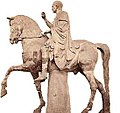Contents
- Rome
- Assisi
- Asti
- Bergamo
- Bologna
- Brescia
- Casale Monferrato
- Ferrara
- Fiesole
- Florence
- Genova
- La Spezia
- Livorno
- Lodi
- Milan
- Naples
- Padua
- Perugia
- Piacenza
- Pistoia
- Ponte Gardena
- Rovigo
- Savona
- Turin
- Venice
- Verona
- References


This is a list of equestrian statues in Italy.
Frequently represented persons:
- Giuseppe Garibaldi (1807–1882), celebrated as one of the greatest generals of modern times [1] and as the "Hero of the Two Worlds" because of his military enterprises in South America and Europe, [2] who fought in many military campaigns that led to Italian unification. He was a general, revolutionary and republican. He is considered to be one of Italy's "fathers of the fatherland".
- Victor Emmanuel II (1820–1878), Italian: Vittorio Emanuele II. He was King of Sardinia (also informally known as Piedmont–Sardinia) from 23 March 1849 until 17 March 1861, when he assumed the title of King of Italy and became the first king of an independent, united Italy since the 6th century, a title he held until his death in 1878. Borrowing from the old Latin title Pater Patriae of the Roman emperors, the Italians gave him the epithet of "Father of the Fatherland" (Italian : Padre della Patria).


















































